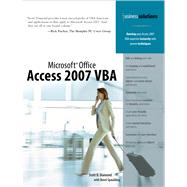Microsoft Office Access 2007 VBA builds on the skills you’ve already developed in creating database applications and helps you take them to the next level–using Visual Basic for Applications (VBA) to accomplish things you once performed manually. To facilitate this lofty goal, Access includes the VBA programming language. Even if you’ve never programmed, this book will help you learn how to leverage the power of VBA to make your work with Access more efficient than ever before.
Microsoft Office Access 2007 VBA is for professionals who use Microsoft Access frequently in their daily work. You have serious work to get done and you can’t spend all day reading a computer book. This book teaches you the essential skills you need to automate your databases as quickly as possible.
Although written for Access 2007, the techniques and concepts covered will work in most versions of Microsoft Access.
Highlights of This Book Include
• Navigating within the Visual Basic Editor
• Using variables, constants, and data types
• Employing built-in functions
• Creating procedures
• Understanding object-and event-driven coding
• Working with arrays
• Understanding scope
• Working with forms
• Using selection controls
• Creating reports
• Exploring menus, navigation, and ribbons
• Using object models
• Working with data
• Defining database schema
• Using the Windows API
• Working with XML files
• Exploring Access SQL








